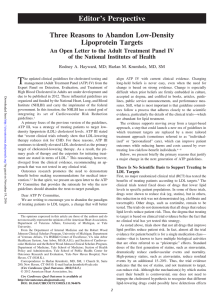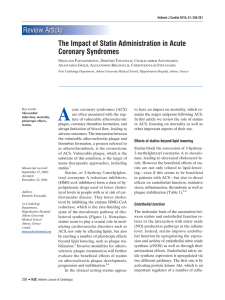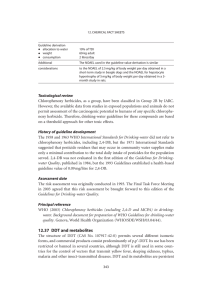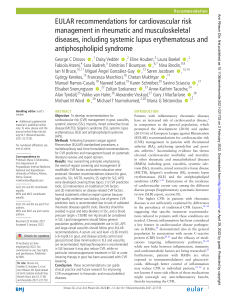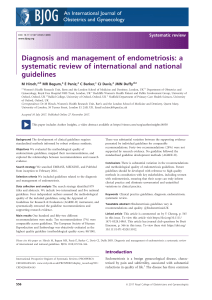spanish interdisciplinary committee for cardiovascular disease
Anuncio
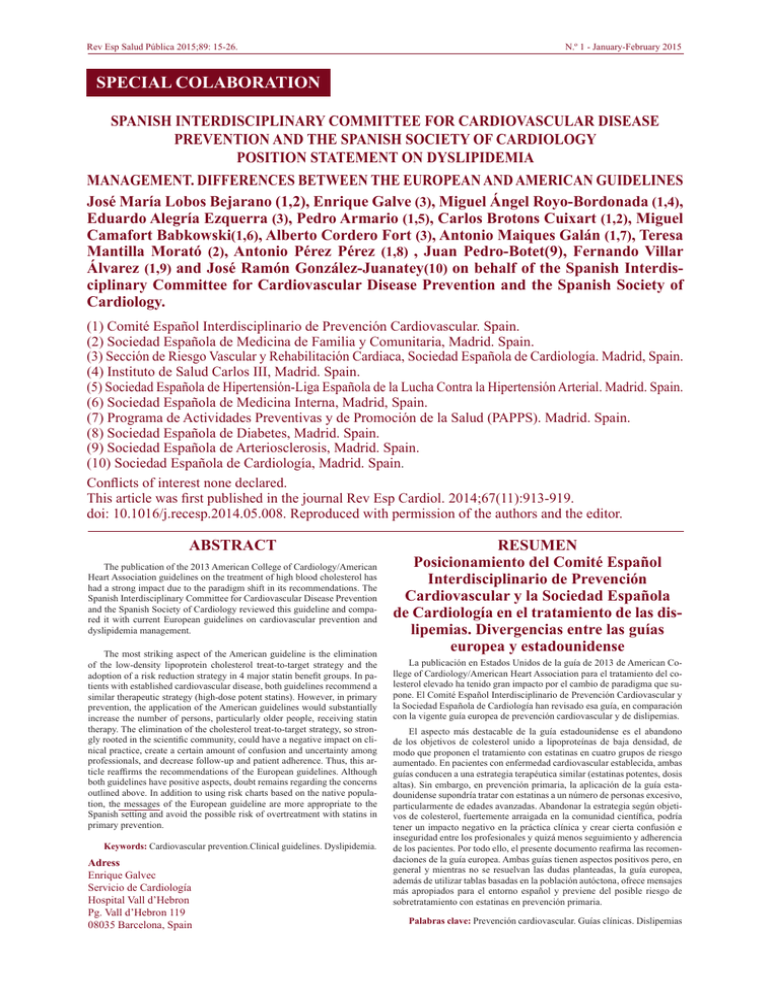
Rev Esp Salud Pública 2015;89: 15-26. N.º 1 - January-February 2015 SPECIAL COLABORATION SPANISH INTERDISCIPLINARY COMMITTEE FOR CARDIOVASCULAR DISEASE PREVENTION AND THE SPANISH SOCIETY OF CARDIOLOGY POSITION STATEMENT ON DYSLIPIDEMIA MANAGEMENT. DIFFERENCES BETWEEN THE EUROPEAN AND AMERICAN GUIDELINES José María Lobos Bejarano (1,2), Enrique Galve (3), Miguel Ángel Royo-Bordonada (1,4), Eduardo Alegría Ezquerra (3), Pedro Armario (1,5), Carlos Brotons Cuixart (1,2), Miguel Camafort Babkowski(1,6), Alberto Cordero Fort (3), Antonio Maiques Galán (1,7), Teresa Mantilla Morató (2), Antonio Pérez Pérez (1,8) , Juan Pedro-Botet(9), Fernando Villar Álvarez (1,9) and José Ramón González-Juanatey(10) on behalf of the Spanish Interdisciplinary Committee for Cardiovascular Disease Prevention and the Spanish Society of Cardiology. (1) Comité Español Interdisciplinario de Prevención Cardiovascular. Spain. (2) Sociedad Española de Medicina de Familia y Comunitaria, Madrid. Spain. (3) Sección de Riesgo Vascular y Rehabilitación Cardiaca, Sociedad Española de Cardiología. Madrid, Spain. (4) Instituto de Salud Carlos III, Madrid. Spain. (5) Sociedad Española de Hipertensión-Liga Española de la Lucha Contra la Hipertensión Arterial. Madrid. Spain. (6) Sociedad Española de Medicina Interna, Madrid, Spain. (7) Programa de Actividades Preventivas y de Promoción de la Salud (PAPPS). Madrid. Spain. (8) Sociedad Española de Diabetes, Madrid. Spain. (9) Sociedad Española de Arteriosclerosis, Madrid. Spain. (10) Sociedad Española de Cardiología, Madrid. Spain. Conflicts of interest none declared. This article was first published in the journal Rev Esp Cardiol. 2014;67(11):913-919. doi: 10.1016/j.recesp.2014.05.008. Reproduced with permission of the authors and the editor. ABSTRACT The publication of the 2013 American College of Cardiology/American Heart Association guidelines on the treatment of high blood cholesterol has had a strong impact due to the paradigm shift in its recommendations. The Spanish Interdisciplinary Committee for Cardiovascular Disease Prevention and the Spanish Society of Cardiology reviewed this guideline and compared it with current European guidelines on cardiovascular prevention and dyslipidemia management. The most striking aspect of the American guideline is the elimination of the low-density lipoprotein cholesterol treat-to-target strategy and the adoption of a risk reduction strategy in 4 major statin benefit groups. In patients with established cardiovascular disease, both guidelines recommend a similar therapeutic strategy (high-dose potent statins). However, in primary prevention, the application of the American guidelines would substantially increase the number of persons, particularly older people, receiving statin therapy. The elimination of the cholesterol treat-to-target strategy, so strongly rooted in the scientific community, could have a negative impact on clinical practice, create a certain amount of confusion and uncertainty among professionals, and decrease follow-up and patient adherence. Thus, this article reaffirms the recommendations of the European guidelines. Although both guidelines have positive aspects, doubt remains regarding the concerns outlined above. In addition to using risk charts based on the native population, the messages of the European guideline are more appropriate to the Spanish setting and avoid the possible risk of overtreatment with statins in primary prevention. Keywords: Cardiovascular prevention.Clinical guidelines. Dyslipidemia. Adress Enrique Galvec Servicio de Cardiología Hospital Vall d’Hebron Pg. Vall d’Hebron 119 08035 Barcelona, Spain RESUMEN Posicionamiento del Comité Español Interdisciplinario de Prevención Cardiovascular y la Sociedad Española de Cardiología en el tratamiento de las dislipemias. Divergencias entre las guías europea y estadounidense La publicación en Estados Unidos de la guía de 2013 de American College of Cardiology/American Heart Association para el tratamiento del colesterol elevado ha tenido gran impacto por el cambio de paradigma que supone. El Comité Español Interdisciplinario de Prevención Cardiovascular y la Sociedad Española de Cardiología han revisado esa guía, en comparación con la vigente guía europea de prevención cardiovascular y de dislipemias. El aspecto más destacable de la guía estadounidense es el abandono de los objetivos de colesterol unido a lipoproteínas de baja densidad, de modo que proponen el tratamiento con estatinas en cuatro grupos de riesgo aumentado. En pacientes con enfermedad cardiovascular establecida, ambas guías conducen a una estrategia terapéutica similar (estatinas potentes, dosis altas). Sin embargo, en prevención primaria, la aplicación de la guía estadounidense supondría tratar con estatinas a un número de personas excesivo, particularmente de edades avanzadas. Abandonar la estrategia según objetivos de colesterol, fuertemente arraigada en la comunidad científica, podría tener un impacto negativo en la práctica clínica y crear cierta confusión e inseguridad entre los profesionales y quizá menos seguimiento y adherencia de los pacientes. Por todo ello, el presente documento reafirma las recomendaciones de la guía europea. Ambas guías tienen aspectos positivos pero, en general y mientras no se resuelvan las dudas planteadas, la guía europea, además de utilizar tablas basadas en la población autóctona, ofrece mensajes más apropiados para el entorno español y previene del posible riesgo de sobretratamiento con estatinas en prevención primaria. Palabras clave: Prevención cardiovascular. Guías clínicas. Dislipemias José María Lobos Bejarano et al. INTRODUCTION Hypercholesterolemia affects 1 in 2 adults in Spain1 and is one of the major risk factors for atherosclerotic vascular disease. The major atherothrombotic complications of hypercholesterolemia lead to elevated morbidity and are the main cause of death worldwide.2 Thus, the prevention and management of hypercholesterolemia in the context of cardiovascular risk management is a crucial issue for physicians and other health professionals. For this reason, various scientific institutions have developed clinical practice guidelines that discuss and summarize the available scientific evidence and provide recommendations in line with the guidelines. The European guidelines for dyslipidemia management and cardiovascular prevention, respectively published in 2011 and 2012 by the task force of the ESC/EAS (European Society of Cardiology/European Atherosclerosis Society),3,4 were well received in Spain and prompted various initiatives for their implementation.5,6 The American College of Cardiology/American Heart Association (ACC/AHA) guidelines were published in late 2013,7 and immediately sparked controversy on both sides of the Atlantic. Although the European and American guidelines agree in many respects, they also differ on other important points, such as the drastic change in the approach to the initial application of lipid-lowering therapy and therapeutic targets, which has led to some confusion and uncertainty among many professionals, who question which approach is the best to follow. In response to this controversy, this article has been prepared by a group of physicians from different specialties and areas of work at the initiative of the Spanish Interdisciplinary Committee for Cardiovascular Disease Prevention (appendix 1) and the Spanish Society of Cardiology. 16 COMMENTARY ON THE METHODOLOGY OF BOTH GUIDELINES The European and American guidelines use a similar system for grading the strength of evidence and strength of recommendation. Both guidelines use the COR/ LOE (Class of Recommendation/Level of Evidence); system. The ESC/EAS combines this system with the GRADE (Grading of Recommendations Assessment, Development, and Evaluation) system3,4 and recommendations can be strong or weak. The ACC/AHA uses the National Heart Lung and Blood Institute grading system, which ranges from class A (strong recommendation) to class E (expert opinion).7 The European guideline presents a wide range of clinical information that covers the entire spectrum of cardiovascular prevention, whereas the American guideline succinctly reviews the issues that the experts consider critical. The European guideline comprehensively discusses the process of the detection, management, and treatment of patients with dyslipidemia and addresses the assessment of cardiovascular risk and laboratory parameters, treatment goals, recommended lifestyle changes, and drugs that have proven useful in the treatment of dyslipidemia. It also addresses the issues of low values of high-density lipoprotein cholesterol and hypertriglyceridemia, the treatment of dyslipidemia in special situations, the follow-up of patients undergoing drug therapy, and finally, measures to improve treatment adherence among these patients. In contrast, the ACC/AHA guideline answers very specific clinical questions that are considered relevant regarding evidence on the use of therapeutic targets and the efficacy and safety of lipid-lowering drugs, particularly statins, in cardiovascular prevention. A major limitation of the ACC/AHA guideline is that it only includes data from randomized clinical trials, as based on the Rev Esp Salud Pública 2015. Vol. 89, N.º 1 SPANISH INTERDISCIPLINARY COMMITTEE FOR CARDIOVASCULAR DISEASE PREVENTION AND THE SPANISH SOCIETY OF... recommendations of the Institute of Medicine.8 This makes it difficult to generalize the results to the general population, because participants in trials are usually high-risk individuals. Thus, the recommendations of the American guidelines, strictly interpreted, would only apply to individuals with similar characteristics. In addition, as drug therapy is easier to evaluate by randomized clinical trials than lifestyle modification interventions, the exclusion of other evidence from observational studies (cohort and case-control), surveys, and registries may result in guidelines that promote the excessive use of drugs at the cost of promoting healthy eating, physical activity, and tobacco cessation. Asymptomatic individuals or those with subclinical disease perceive risk differently and their acceptance of and adherence to long-term drug therapy is more complicated than that of patients who require medical care after experiencing an acute cardiovascular event.9 In addition, the lower the cardiovascular risk, the lower the overall benefit-to-risk ratio of statin therapy.10 Therefore, in primary prevention, the decision to administer statin therapy should take into account the preferences of the individuals susceptible to intervention, after seriously assessing nondrug measures (diet, physical activity, and tobacco cessation), and the balance between the potential benefits and risks of intervention should be discussed in depth with the patient. However, the American guideline, despite its apparent patient-centered approach, in which the patient would have participated in decision-making, strongly recommends statin therapy for people with cardiovascular risk ≥7.5% (race- and sexspecific pooled cohort equations). Although not directly comparable, this risk would be equivalent to intermediate risk in the traditional Framingham risk scale. In contrast, the European guideline for individuals with moderate risk (SCORE [Systematic Coronary Risk Evaluation] >1% but <5%) recommends drug therapy only when the other Rev Esp Salud Pública 2015. Vol. 89, N.º 1 measures referred to have not achieved the goal of controlling low-density lipoprotein cholesterol (LDL-C). POINTS OF AGREEMENT Although greater emphasis is usually placed on differences, the European and the new American guidelines have a series of points in common that are worth highlighting: 1. Both guidelines emphasize elevated LDL-C levels as a major risk factor and the importance of LDL-C reduction in the prevention and management of cardiovascular disease (CVD). 2. Both emphasize the importance of risk stratification in cardiovascular prevention and recommend not only estimation of coronary risk, but also assessment of total CVD risk as an essential element in the decision to initiate lipid-lowering therapy. 3. Both consider that lifestyle changes are the foundation of health promotion and CVD risk reduction. 4. When clinical assessment suggests that risk has been underestimated as moderate, the European guideline emphasizes the relevance of a family history of premature CVD and suggests measuring high-sensitivity Creactive protein, fibrinogen, and homocysteine levels, ankle-brachial index, carotid intima-media thickness, and intracoronary calcium, and even performing an exercise stress test. Although the American guideline is more conservative regarding potential risk markers/imaging techniques, it is in agreement with the European guideline regarding the inclusion of a family history of premature CVD, high-sensitivity C-reactive protein, ankle-brachial index, and intracoronary calcium. 5. For patients at very high risk, the European guideline includes the option of reducing the LDL-C level to 50% of the untreated baseline level if the therapeutic goal of 17 José María Lobos Bejarano et al. LDL-C <70 mg/dL (<1.8 mmol/L) is not achieved. The American guideline recommend the immediate implementation of high-intensity statin therapy, which reduces LDL-C to <50%. 6. For statin-intolerant patients, both guidelines recommend reducing the dose, using drug combinations, or other alternatives. 7. In primary prevention and patients with LDL-C ≥190 mg/dL (>4.9 mmol/L), the American guidelines recommend highintensity statin therapy or, if not tolerated, moderate-intensity statin therapy, either alone or in combination with alternative therapies when there is an insufficient response to the maximum tolerated dose of statin. The European guideline recommends an LDL-C goal <100 mg/dL and, if this is not achieved with statin therapy, suggests that the addition of a second drug should be considered. 8. Both guidelines recommend more intensive treatment for patients with diabetes mellitus and other risk factors or target organ damage: the ESC/EAS recommends an LDL-C target <70 mg/dL (<1.8 mmol/L) and the ACC/AHA recommends high-intensity treatment. Both guidelines recommend less intensive treatment for patients with low-risk diabetes mellitus: the ESC/ EAS advocates an LDL-C target <100 mg/ dL (<2.5 mmol/L) and the ACC/AHA recommends moderate-intensity treatment. 9. Finally, both guidelines recommend a more conservative approach for patients > 75 years, although the American guideline explicitly includes age as a determinant of treatment intensity. POINTS OF DISAGREEMENT There are marked differences between the guidelines regarding the estimation of overall cardiovascular risk in primary prevention: 18 1. The American guideline recommends the use of a wider age range (35-64 years in SCORE and 35-79 years in race- and sexspecific pooled cohort equations). 2. Cardiovascular events of interest in SCORE only include fatal events (risk of a first fatal atherosclerotic cardiovascular event, including all atherosclerosis-related diagnoses of the International Classification of Diseases), whereas the American guideline also includes nonfatal events (risk of cardiovascular morbidity and mortality, including coronary heart disease, stroke, and peripheral arterial disease). However, the European guideline on overall cardiovascular risk includes morbidity and thus risk is about 3 times higher than that in the risk charts, although this factor varies with age and sex. 3. The American guideline includes diabetes mellitus and hypertension treatment among the predictive variables in addition to those included in the European guideline: age, total cholesterol and high-density lipoprotein cholesterol, systolic blood pressure, and tobacco use. 4. Regarding risk assessment and communication in young people, the European guideline recommends calculating the relative risk or vascular age, whereas the American guideline recommends estimating cardiovascular risk at 30 years. 5. Finally, the European guideline on risk assessment explicitly includes psychosocial factors and contains a specific section on the topic. The greatest differences concern the recommendations for the treatment of hypercholesterolemia and especially the definition of risk categories and therapeutic targets (table 1). The European guideline defines 4 risk categories and therapeutic goals consistent with them, whereas the American guideline, instead of risk categories, establishes 4 patient groups with an indication for statin therapy and the dose that should be used Rev Esp Salud Pública 2015. Vol. 89, N.º 1 SPANISH INTERDISCIPLINARY COMMITTEE FOR CARDIOVASCULAR DISEASE PREVENTION AND THE SPANISH SOCIETY OF... Table 1 Risk Estimation and Classification in the European and American Guidelines ESC/EAS 2011 Guideline* AHA/ACC 2013 Guideline† Very high risk High risk (high-intensity statins) Documented CVD Documented CVD DM1 or DM2 ≥ 1 CVRF and/or target organ damage LDL-C > 190 mg/dL and age ≤ 75 years Severe CKD (GFR < 30 mL/min/1.73 m2) DM LDL-C levels of 70 mg/dL-189 mg/dL, age from 40 years to 74 years and PCRAE risk ≥ 7.5% SCORE risk ≥ 10% High risk Moderate risk (moderate-intensity statins) A single markedly elevated risk factor (familial dyslipidemia, severe hypertension) LDL-C > 190 mg/dL and age > 75 years DM1 or DM2 without other CVRFs and target organ damage DM with LDL-C levels of 70 mg/dL-189 mg/dL, age from 40 years to 74 years and PCRAE risk < 7.5% Moderate CKD (GFR, 30-60 mL/min/1.73 m2) PCRAE risk ≥ 7.5% SCORE risk ≥ 5% but < 10% Moderate risk Low risk SCORE risk ≥ 1% but < 5% Rest of the population Low risk SCORE risk < 1% AHA/ACC, American Heart Association/American College of Cardiology; CKD, chronic kidney disease; CVD, cardiovascular disease; CVRF, cardiovascular risk factor; DM1, diabetes mellitus type 1; DM2, diabetes mellitus type 2; ESC/EAS, European Society of Cardiology/European Atherosclerosis Society; GFR, estimated glomerular filtration rate; LDL-C, low-density lipoprotein cholesterol; PCRAE, Pooled Cohort Risk Assessment Equations; SCORE, Systematic Coronary Risk Evaluation. * Clearly defined in the European guidelines. † Risk levels based on 4 major statin benefit groups identified in clinical trials. in each case. The strategy of the American guideline to reduce cardiovascular morbidity and mortality is based on randomized clinical trials that used fixed doses of statin (vs placebo, vs other statin and/or other doses), whereas it did not assess the use of statins with dose adjustment to achieve the therapeutic targets. This reasoning is in line with the current draft of the British guideline of the National Institute for Health and Care Excellence on cardiovascular risk assessment and lipid modification for cardiovascular prevention.11 Finally, the American guideline focuses its recommendations on statin use and defines 3 treatment levels (high-, moderate-, and low-intensity), according to the different statins and dosages. The use of other lipidRev Esp Salud Pública 2015. Vol. 89, N.º 1 lowering drugs, such as fibrates, nicotinic acid, ion-exchange resins, cholesterol absorption inhibitors, and omega-3 fatty acids, is only recommended for high-risk individuals with confirmed statin intolerance after dose reduction or even after a change of statin. There is no evidence demonstrating the efficacy of these other drugs in reducing cardiovascular events either in isolation or in combination with a statin. Fenofibrate may be used with a low- or moderate-intensity statin only if the expected benefits of cardiovascular risk reduction or triglyceride reduction when triglycerides are > 500 mg/ dL outweigh the potential risk of adverse effects (class IIb). However, the European guideline includes these drug groups in 3 clinical situations: a) in cases of statin in- 19 José María Lobos Bejarano et al. tolerance: ion-exchange resins (class IIa/B), ezetimibe alone, or ezetimibe combined with ion-exchange resins (class IIb/C); b) if the LDL-C target is not reached with the maximum tolerated statin dose: statin + ezetimibe or ion-exchange resins (class IIb/C); and c) high-risk patients with hypertriglyceridemia: fibrates (class I/b) or combined with fibrates (not gemfibrozyl) + statin (class IIa/B). Attention is also drawn to hypertriglyceridemia as a cause of pancreatitis, even at concentrations of 450-900 mg/dL, and the importance of nondrug treatment (caloric reduction, abstinence from alcohol, diabetes mellitus, etc) and drug treatment (fibrates). IMPLICATIONS FOR CLINICAL PRACTICE In secondary prevention, the European guideline recommends a therapeutic LDL-C target of <70 mg/dL or an LDL-C reduction of ≥50%, whereas the strategy of the American guideline clearly departs from targeted levels, which for clinicians represents the most dramatic paradigm shift in clinical practice in years. The American guideline suggests a ``high-intensity’’ statin strategy to achieve an LDL-C target of <70 mg/dL in most patients, thus reducing the difference between the 2 strategies in clinical practice. In addition, although absolute lipid targets have been eliminated, it is implicitly assumed that the therapeutic target is a percent LDL-C reduction that is determined for each of the defined groups. The absence of LDL-C targets in the American guidelines makes their control unnecessary; however, the guidelines recommend the promotion of adherence and the assessment of individuals for possible adverse effects (eg, myopathy), especially if there are symptoms or risk factors. This new strategy eliminates the concept of control associated with a therapeutic target and involves the loss of a useful tool to optimize adherence.12 Although this recommendation would simplify treatment and follow-up, the guidelines do not specify the duration of this treatment. 20 The American classification of statins according to potency is a positive contribution as it indicates the statins and dosage to use according to individual risk.12 Of the 3 groups defined in primary prevention, the recommendation to treat patients ≥21 years with LDL-C >190 mg/dL (considered to be due to genetic hyperlipidemia) with highintensity statins will lead to more patients receiving statins and at higher doses. The American recommendations are similar to those of the European guidelines for diabetic patients aged 40-75 years with LDL-C from 70 mg/dL to 189 mg/dL without established CVD, but the question of how to treat patients <40 years remains open. Controversy is high regarding the third group of patients with LDL-C from 70 mg/dL to 189 mg/dL and an estimated 10-year cardiovascular risk ≥7.5%, due to the use of a risk calculator based on an American cohort of white and Afro-American individuals. Its use has been criticized for overestimating risk by setting an arbitrary threshold of 7.5% and modifying risk if it is between 5% and 7.5%. In contrast, the European guidelines recommend using the SCORE risk charts (European population, including a Spanish population), and the International Atherosclerosis Society position paper 201313 and the National Institute for Health and Care Excellence guideline 201411 recommend using risk charts based on the native population. Given these recommendations, it is not advisable to use charts based on populations with very different risk levels, as in the case under discussion. Alternative lipid-lowering drugs (fibrates, ezetimibe, ion-exchange resins, etc) that lack a scientifically proven benefit for cardiovascular prognosis in secondary prevention are relegated to second place in the American guideline, whereas their use is recommended in the European guideline, particularly when a potent statin fails to achieve the recommended lipid target. The use of combination therapy would be consistent with a strategy aimed at achieving strict target levels. Rev Esp Salud Pública 2015. Vol. 89, N.º 1 SPANISH INTERDISCIPLINARY COMMITTEE FOR CARDIOVASCULAR DISEASE PREVENTION AND THE SPANISH SOCIETY OF... Finally, the American guideline clearly defines the risk factors for the adverse effects of statins and notes that creatine kinase determination should not be routine except in symptomatic patients or before treatment when there is a risk of myotoxicity. This strategy would avoid unnecessary follow-up visits and, quite possibly, the incorrect discontinuation of drug treatment.12 Compared with the European guidelines, the American guidelines stress the need for caution regarding the potential side effects of statins, although in practice it is known that the incidence of side effects is very low, as shown by extensive evidence regarding their safety and use. This cautionary note may be due to the American guidelines recommending the increased use of statins, higher potency statins, and higher doses. SOCIO-ECONOMIC IMPLICATIONS IN SPAIN The economic assessment of health interventions is considered to be very useful in making decisions on the incorporation of healthcare innovations and optimal resource use. In the current economic crisis, there is an increased need to apply efficiency criteria in the allocation of limited resources. Economic assessment shows that statins are cost-effective compared with nonactive treatment in the secondary prevention of CVD and in primary prevention in highrisk patients, but their cost-effectiveness is less clear as risk decreases.14 Thus, it is important to determine the economic impact of the drastic change involved in the new treatment strategy recommended in the American guideline. Available economic assessments provide no evidence that some statins are more costeffective than others at equipotent doses in primary or secondary prevention. In Spain, the consumption of lipid-lowering drugs increased by 442% between 2000 and 2012 (from 18.9 defined daily doses in 2000 to 102.6 defined daily doses in 2012) and statins accounted for 89.3% of lipid-lowering Rev Esp Salud Pública 2015. Vol. 89, N.º 1 drug use in 2012 (atorvastatin and simvastatin accounted for 78.2% of this percentage).15 However, the 26.4% increase in the use of statins between 2009 and 2011 was accompanied by a decrease in costs from 622 million euros to 366 million euros, due to almost all the currently available statins being generic drugs, thus minimizing the economic impact of their increased use and higher doses.16 The cost of the lipid-lowering therapy recommended in the guidelines depends on the target population that meets the criteria and on treatment intensity. This treatment intensity is based on the set LDL-C targets, as in the European guideline, or on moderate- to high-intensity therapy, depending on the statin dose, as in the American guideline. Regarding the target population amenable to drug treatment, the European guideline specifically includes the subgroup of patients with kidney failure. It remains unknown which population includes each of the thresholds established with the respective risk charts. In the United States, it is estimated that the application of the new guidelines would lead to 32.8% of the population aged from 40 years to 79 years (44.3% of men and 22.5% women) exceeding the risk level of 7.5%,17 although the risk charts may overestimate this risk by between 75% and 150%.18 The application of the new recommendations, using the risk factor profile of the cohort of the NHANES-III (National Health and Nutrition Examination Survey-III) 2005-2010 (3773 participants), extrapolated to the entire United States population aged from 40 years to 75 years (115.4 million people), would increase the number of people eligible for statin treatment from 43.2 million (37.5%) to 56 million (48.6%), and most of this difference (10.4 million of 12.8 million people) would be represented by people without CVD.19 In the subgroup of patients from 60 years to 75 years (primary prevention), there would be an increa21 José María Lobos Bejarano et al. Table 2 Position and Recommendations of the Spanish Interdisciplinary Committee for Cardiovascular Disease Prevention and the Spanish Society of Cardiology on Dyslipidemia Management Position and recommendations Comment Patients with clinical CVD (secondary prevention) Other patients at very high risk Continue to recommend LDL-C target: < 70 mg/dL (< 1.8 mmol/L) or a reduction ≥ 50% from baseline Most patients require higher doses of potent statins; in clinical practice, this recommendation minimizes the differences between the guidelines Decreased costs and decreased adverse drug effects in patients with slightly elevated baseline LDL-C levels (relatively common in the Spanish Mediterranean population) Primary prevention High risk: A single markedly elevated risk factor (familial dyslipidemia, severe hypertension) DM1 or DM2 without other CVRFs or target organ damage Moderate CKD (GFR, 30-59 mL/ min/1.73 m2) The recommended treatment target is: LDL-C < 100 mg/dL (< 2.5 mmol/L) Regarding the American guidelines, decreased costs and decreased adverse drug effects. The recommendations of the American guidelines are based on RCT alone without integrating all the available scientific evidence SCORE ≥ 5% but < 10% Moderate risk: SCORE ≥ 1 but < 5% or Low risk: SCORE < 1% A recommended therapeutic target is: total cholesterol < 190 mg/dL (< 5 mmol/L) There is no solid evidence supporting the use of thresholds or cutoff points to define risk categories. The lower the baseline cardiovascular risk the less clear the balance LDL-C < 115 mg/dL (< 3 mmol/L) between the risk-benefit and costeffectiveness of statin therapy Calculators for estimating cardiovascular risk In Spain, the use of European SCORE charts for low-risk countries continues to be the recommendation Risk charts should be based on the local population. The American guidelines include populations with characteristics that markedly differ from Spanish populations Use of drugs other than statins Absorption inhibitors, such as ezetimibe or ion-exchange resins, plus statin as combination therapy to achieve LDL-C targets. Hypertriglyceridemia and/or low HDL-C are independent risk factors that should be taken into account. If they persist, intensive lifestyle modification and drugs (fibrates) should be considered. Omega-3 fatty acids are another option to reduce triglycerides Moderate hypertriglyceridemia is associated with higher cardiovascular risk than severe hypertriglyceridemia (triglycerides > 900 mg/dL), which is a risk factor for pancreatitis that itself requires treatment (fibrates). The results of the IMPROVE-IT study assist in defining the role of combination therapy CKD, chronic kidney disease; CVD, cardiovascular disease; CVRF, cardiovascular risk factor; GFR, glomerular filtration rate; HDL-C, high-density lipoprotein cholesterol; IMPROVE-IT, IMProved Reduction of Outcomes Vytorin Efficacy International Trial; RCT, randomized clinical trials; SCORE, Systematic Coronary Risk Evaluation LDL-C, low-density lipoprotein cholesterol. 22 Rev Esp Salud Pública 2015. Vol. 89, N.º 1 SPANISH INTERDISCIPLINARY COMMITTEE FOR CARDIOVASCULAR DISEASE PREVENTION AND THE SPANISH SOCIETY OF... se from 30.4% to 87.4% in men and from 21.2% to 53.6% in women. Using data from the Swiss CoLaus Study, which included a sample of 3297 people between 50 years and 75 years, it was estimated that the use of the new American charts would more than double the number of people eligible for lipid-lowering treatment compared with the use of the European charts, and that this difference would be much larger in the 50 years to 60 years old age group.20 If these data are extrapolated to the Swiss population, the application of the American guideline would increase the annual costs of treatment in cardiovascular prevention by 333.7 million euros. Finally, the American guideline does not recommend the use of other lipid-lowering treatments, such as ezetimibe or fibrates combined with statins, or recommends their restricted use, whereas the European guideline supports their use to achieve therapeutic targets, despite the level of evidence being suboptimal. This latter circumstance would lead to higher direct treatment costs. FINAL ANALYSIS AND RECOMMENDATIONS OF THE SPANISH INTERDISCIPLINARY COMMITTEE FOR CARDIOVASCULAR DISEASE PREVENTION AND THE SPANISH SOCIETY OF CARDIOLOGY The new strategy of the ACC/AHA, based on treatment with high- or moderate intensity statins for 4 well-defined groups of patients, represents a substantial change from the recommendations of the European guidelines and from the previous Adult Treatment Panel-III (focused on specific LDL-C targets depending on the baseline lipid concentrations and cardiovascular risk), which was also based on the results of large randomized clinical trials and meta-analyses conducted during the last 20 years.21–23 Nevertheless, it is worth emphasizing that the proposal does not involve large differences in recommendations for patients at high and very high risk. However, it seems clear that Rev Esp Salud Pública 2015. Vol. 89, N.º 1 their application in clinical practice would lead to overtreatment in primary prevention in moderate- to high-risk patients, particularly among elderly patients, due to the recommendation of systematic drug treatment and the predominance of a high-intensity strategy over a moderate-intensity strategy.24 Paradoxically, these recommendations disregard the available treatment options currently used to help achieve treatment targets. This paradigm shift may lead to the elimination of laboratory testing and could have a negative impact on patients (perceived decrease in follow-up and monitoring, reduced medication adherence). It could also negatively impact physicians, who are unaccustomed to treat patients blindly and are used to a well-founded working method based on knowing and applying the clinical practice guidelines and treatment targets that have been widespread and accepted in the scientific community for many years.24 One of the strengths of the European guideline that has contributed the most to its implementation in Spain is the definition of clear objectives according to cardiovascular risk and the prioritization of higher-risk patients on whom to focus the full range of preventive interventions. Indicators based on the achievement of targets have helped to identify the degree of implementation of the guidelines in different contexts via extensive evaluation studies, and to establish strategies to improve the quality of clinical care for specific patients and populations.25 Moreover, measurement of lipid concentrations can serve to indicate therapeutic response, improve treatment adherence, help to promote lifestyle changes, and identify situations in which combination therapy would be indicated. The current position of the Spanish Interdisciplinary Committee for Cardiovascular Prevention and the Spanish Society of Cardiology (table 2) reaffirms the recommendations of the European guidelines on 23 José María Lobos Bejarano et al. dyslipidemia and cardiovascular disease prevention in clinical practice that are currently in force. Both entities provided comments on these guidelines at the time of their publication.5,6 The guidelines should be a dynamic instrument, open to new evidence and inputs, and flexible in their application according to changing healthcare environments. It is always positive to analyze changes of focus in other settings, but this should not detract from approaches based on the best available scientific evidence using costeffectiveness criteria (which is not confined to large randomized clinical trials), and on a consolidated strategy for education, training, knowledge, and the application of the guidelines, which seeks to maintain and improve the health outcomes of our patients and the general population. CONCLUSIONS The publication of the ACC/AHA 2013 guideline demonstrates that there are aspects to be clarified regarding the treatment of dyslipidemia and many other points related to overall consensus. The central role of LDL-C in diagnosis and treatment and statin therapy are the 2 aspects on which both guidelines are in undisputed agreement. However, the European 2011 guideline provides better-validated approaches to risk stratification than those proposed by the American guideline which, in addition, would increase the number of people who should receive lipid-lowering therapy. This increase would entail the obvious risk of unnecessary drug therapy in primary prevention, particularly for older people. The treatment goal of the American guideline is that the intensity of statin therapy should be assessed according to individual risk, whereas the European guideline recommends LDL-C targets for each risk category. This change in paradigm could confuse physicians, which would set up a new barrier to the application of the guideline, and also negatively impact patients, which could result in the perception of decreased follow-up and monitoring and 24 reduced medication adherence. Both guidelines have positive aspects but, in general and while questions remain unresolved, the message of the European guideline is more appropriate to the Spanish setting and prevents possible overtreatment in primary prevention. BIBLIOGRAPHY 1. Guallar-Castillón P, Gil-Montero M, León-Muñoz LM, Graciani A, Bayán-Bravo A, Taboada JM, et al. Magnitud y manejo de la hipercolesterolemia en la población adulta de España, 2008-2010: el estudio ENRICA. Rev Esp Cardiol. 2012;65:551-8. 2. Lozano R, Naghavi M, Foreman K, Lim S, Shibuya K, Aboyans V, et al. Global and regional mortality from 235 causes of death for 20 age groups in 1990 and 2010: a systematic analysis for the Global Burden of Disease Study 2010. Lancet. 2012;380:2095-128. 3. European Association for Cardiovascular Prevention & Rehabilitation Reiner Z, Catapano AL, De Backer G, Graham I, Taskinen MR, Wiklund O, et al.; ESC Committee for Practice Guidelines (CPG) 2008-2010 and 2010-2012 Committees. ESC/EAS Guidelines for the management of dyslipidaemias: the Task Force for the management of dyslipidaemias of the European Society of Cardiology (ESC) and the European Atherosclerosis Society (EAS). Eur Heart J. 2011; 32:1769-818. 4. Perk J, De Backer G, Gohlke H, Graham I, Reiner Z, Verschuren M, et al.; European Association for Cardiovascular Prevention & Rehabilitation (EACPR); ESC Committee for Practice Guidelines (CPG). European Guidelines on cardiovascular disease prevention in clinical practice (version 2012). The Fifth Joint Task Force of the European Society of Cardiology and Other Societies on Cardiovascular Disease Prevention in Clinical Practice (constituted by representatives of nine societies and by invited experts). Eur Heart J. 2012;33:1635-701. 5. Anguita M, Alegría E, Barrios V, Casasnovas JA, Escobar C, León M, et al. Comentarios a las guías de práctica clínica sobre manejo de las dislipemias de la Sociedad Europea de Cardiología y la Sociedad Europea de Aterosclerosis 2011. Un informe del Grupo de Trabajo del Comité de Guías de Práctica Clínica de la Sociedad Española de Cardiología. Rev Esp Cardiol. 2011;64:1090-5. 6. Royo-Bordonada MA, Lobos Bejarano JM, Villar Álvarez F, Sans S, Pérez A, PedroBotet J, et al. Comentarios del Comité Español Interdisciplinario de Prevención Cardiovascular (CEIPC) a las guías europeas de prevención cardiovascular 2012. Rev Esp Salud Publica. 2013;87:103-20. Rev Esp Salud Pública 2015. Vol. 89, N.º 1 SPANISH INTERDISCIPLINARY COMMITTEE FOR CARDIOVASCULAR DISEASE PREVENTION AND THE SPANISH SOCIETY OF... 7. Stone NJ, Robinson JG, Lichtenstein AH, Bairey Merz CN, Blum CB, Eckel RH et al. 2013 ACC/AHA Guideline on the Treatment of Blood Cholesterol to Reduce Atherosclerotic Cardiovascular Risk in Adults: a report of the American College of Cardiology/American Heart Association Task Force on Practice Guidelines. Circulation. 2014;129(25 Suppl 2):S1-45. 8. Institute of Medicine (US) Committee on Standards for Developing Trustworthy Clinical Practice Guidelines. Clinical practice guidelines we can trust. Washington: National Academies Press; 2011. 9. Sackett DL. The arrogance of preventive medicine. CMAJ. 2002;167:363-4. 10. Reiner Zˇ. Statins in the primary prevention of cardiovascular disease. Nat Rev Cardiol. 2013;10:453-64. 11. National Institute for Health and Care Excellence. Lipid modification. Cardiovascular risk assessment and the modifications of blood lipids for the primary and secondary prevention of cardiovascular disease. NICE guideline. Draft for consultation, February 2014 [cited 2014 Mar 25]. Available at: http://www.nice.org.uk/nicemedia/ live/13637/66552/66552.pdf 12. Civeira F, Ascaso J, Masana L. Should we forget about low-density lipoprotein cholesterol. J Am Coll Cardiol. 2014;63:1228-9. 13. International Atherosclerosis Society. Informe de la Sociedad Internacional de Ateroesclerosis: Recomendaciones generales para el tratamiento de las dislipidemias [cited 2014 Mar 25]. Available at: http://www. athero.org/download/IASGuidelines_FullText_SPANISH_20140107.pdf 14. Ward S, Lloyd Jones M, Pandor A, Holmes M, Ara R, Ryan A, et al. A systematic review and economic evaluation of statins for the prevention of coronary events. Health Technol Assess. 2007;11:1-160. 15. Informe de utilización de medicamentos U/HLP/ V1/17012014. Utilización de medicamentos hipolipemiantes en España durante el periodo 2000-2012. Madrid: Agencia Española de Medicamentos y Productos Sanitarios; 2014 [cited 2014 Mar 25]. Available at: http://www. aemps.gob.es/medicamentosUsoHumano/observatorio/ docs/hipolipemiantes-2000-2012.pdf 18. Ridker PM, Cook NR. Refining the American guidelines for prevention of cardiovascular disease Authors’ reply. Lancet. 2014;383:600. 19. Pencina MJ, Navar-Boggan AM, D’Agostino RB, Williams K, Neely B, Sniderman AD, et al. Application of new cholesterol guidelines to a population-based sample. N Engl J Med. 2014;370:1422-31. 20. Vaucher J, Marques-Vidal P, Preisig M, Waeber G, Vollenweider P. Population and economic impact of the 2013 ACC/AHA guidelines compared with European guidelines to prevent cardiovascular disease. Eur Heart J. 2014;35:958-9. 21. Heart Protection Study Collaborative Group. MRC/ BHF Heart Protection Study of cholesterol lowering with simvastatin in 20,536 high-risk individuals: a randomised placebo-controlled trial. Lancet. 2002;360:722. 22. Cannon CP, Braunwald E, McCabe CH, Rader DJ, Rouleau JL, Belder R, et al.; Pravastatin or Atorvastatin Evaluation and Infection Therapy-Thrombolysis in Myocardial Infarction 22 Investigators. Intensive versus moderate lipid lowering with statins after acute coronary syndromes. N Engl J Med. 2004;350:1495-504. 23. Cholesterol Treatment Trialists Collaboration, Baigent C, Blackwell L, Emberson J, Holland LE, Reith C, Bhala N, et al. Efficacy and safety of more intensive lowering of LDL cholesterol: a meta-analysis of data from 170,000 participants in 26 randomised trials. Lancet. 2010;376:1670-81. 24. Ray KK, Kastelein JJ, Boekholdt SM, Nicholls SJ, Khaw KT, Ballantyne CM, et al. The ACC/AHA 2013 guideline on the treatment of blood cholesterol to reduce atherosclerotic cardiovascular disease risk in adults: the good the bad and the uncertain: a comparison with ESC/EAS guidelines for the management of dyslipidaemias 2011. Eur Heart J. 2014;35:960–8. 25. Kotseva K, Wood D, De Backer G, De Bacquer D, Pyörälä K, Keil U; EUROASPIRE Study Group. EUROASPIRE III: a survey on the lifestyle, risk factors and use of cardioprotective drug therapies in coronary patients from 22 European countries. Eur J Cardiovasc Prev Rehabil. 2009;16:121-37. 16. Huerta Caballo A, Molina Ortiz R, Molina U´ beda JJ. Consumo de estatinas en España (2009/2011). Farmacéuticos Comunitarios. 2012; 4 Supl 1 [cited 2014 Mar 25]. Available at: http://www.farmaceuticoscomunitarios.org/ journal-article/consumo-estatinas-espana-2009-2011 17. Goff DC, Lloyd-Jones DM, Bennett G, Coady S, D’Agostino RB, Gibbons R, et al. 2013 ACC/AHA Guideline on the Assessment of Cardiovascular Risk: a report of the American College of Cardiology/American Heart Association Task Force on Practice Guidelines. Circulation. 2014;129 (25 Suppl 2):S49-73. Rev Esp Salud Pública 2015. Vol. 89, N.º 1 25 José María Lobos Bejarano et al. Appendix 1 Scientific Societies and Institutions Constituting the Spanish Interdisciplinary Committee for Cardiovascular Disease Prevention Instituto de Salud Carlos III Sociedad Española de Medicina de Familia y Comunitaria Sociedad Española de Arteriosclerosis Sociedad Española de Salud Pública y Administración Sanitaria Sociedad Española de Diabetes Sociedad Española de Angiología y Cirugía Vascular Federación de Asociaciones de Enfermería Comunitaria y Atención Primaria Ministerio de Sanidad, Servicios Sociales e Igualdad Sociedad Española de Neurología Sociedad Española de Medicina y Seguridad en el Trabajo Sociedad Española de Epidemiología Sociedad Española de Médicos de Atención Primaria (SEMERGEN) Sociedad Española de Cardiología Sociedad Española de Nefrología Asociación Española de Pediatría de Atención Primaria Sociedad Española de Medicina Interna Sociedad Española de Hipertensión-Liga Española de la Lucha contra la Hipertensión Arterial 26 Revv Esp Salud Pública 2015. Vol. 89, N.º 1


